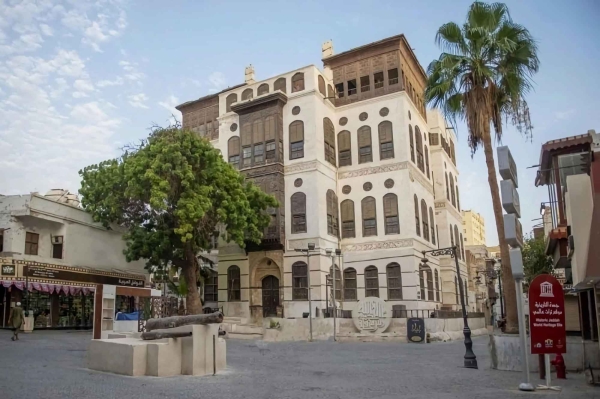
Nassif House is one of the heritage houses in Jeddah Historic District, located in Jeddah City, west of the Kingdom of Saudi Arabia. It gained its historical importance from the arrival of the Founding King Abdulaziz Bin Abdulrahman Al Saud there in 1925, and he took it as his residence for about ten years. Nassif House was built in 1872 by Sheikh Omar Effendi Nassif. Its construction took four years, with an architectural design bearing the characteristics of Hejaz architecture.
Nassif House witnessed important events during the period of unification of Saudi Arabia, as it was where the Founding King Abdulaziz Bin Abdulrahman Al Saud listened to the demands of citizens, and signed a number of agreements with ambassadors and delegates of several countries.
King Abdulaziz also received in Nassif House state guests, a number of presidents, scholars, thinkers, writers, and important figures. The house included a library containing thousands of humanities collections, which were later donated to King Abdulaziz University after the death of Omar Nassif.
Construction of Nassif House
Nassif House was characterized by its Hejaz architecture. During its construction, coral limestone was used, which is a fragile coral stone extracted from the shores of the Red Sea to protect the house from cold and heat, and also reduce humidity. The whiteness of the Limestone plaster was also used to prevent stone corrosion caused by air humidity throughout the year. The house's architectural details, which reflect the urban development of the region at that time, added to its significance within the heritage and antiquities ecosystem.
Area and design of Nassif House
Nassif House covers an area of about nine hundred m and contains forty rooms across four floors. The first floor was designated for receiving guests, while the second floor was prepared for their overnight stay, and the third floor was used by family members. The fourth floor contains gaps in the walls, known as "the windcatchers" that cooled the weather. This was the family's favorite place in the summer.
Nassif House was distinguished by the uniqueness of its building style. Its 'staircase' was designed in a way to facilitate movement between its four floors. The ground floor contains a 'cistern' to collect rainwater. The house also includes an additional annex for the reception room known as the 'Makhlawan.'
The exterior details of Nassif House feature the 'Rawashin' (bay windows), which were some of the most important architectural elements of the Hejaz region at that time, as they add beauty to the remarkable wooden covering of the house's windows and openings.
'Reviving the Heart of the Arabian Peninsula' journey in Nassif House
Nassif House was one of the stops of the 'Reviving the Heart of the Arabian Peninsula' team's journey, which visited the house at the end of the journey in 2023. The team traveled 1,300 km from the center of Saudi Arabia, specifically from Al-Turaif District in Diriyah, to the west of Saudi Arabia to Nassif House. The trip lasted thirteen days and aimed at exploring the desert.
The team was led by Mark Evans and included traveler Reem Philby, British logistics expert Alan Morrissey, and Swiss photographer Anna Maria Pallavacci. The trip sheds light on the historical relationship between Saudi Arabia and Britain, and understanding the nature of the desert. The 'Reviving the Heart of the Arabian Peninsula' journey follows in the footsteps of Abdullah Philby's journey in 1917.
Related quizzes
Related articles

